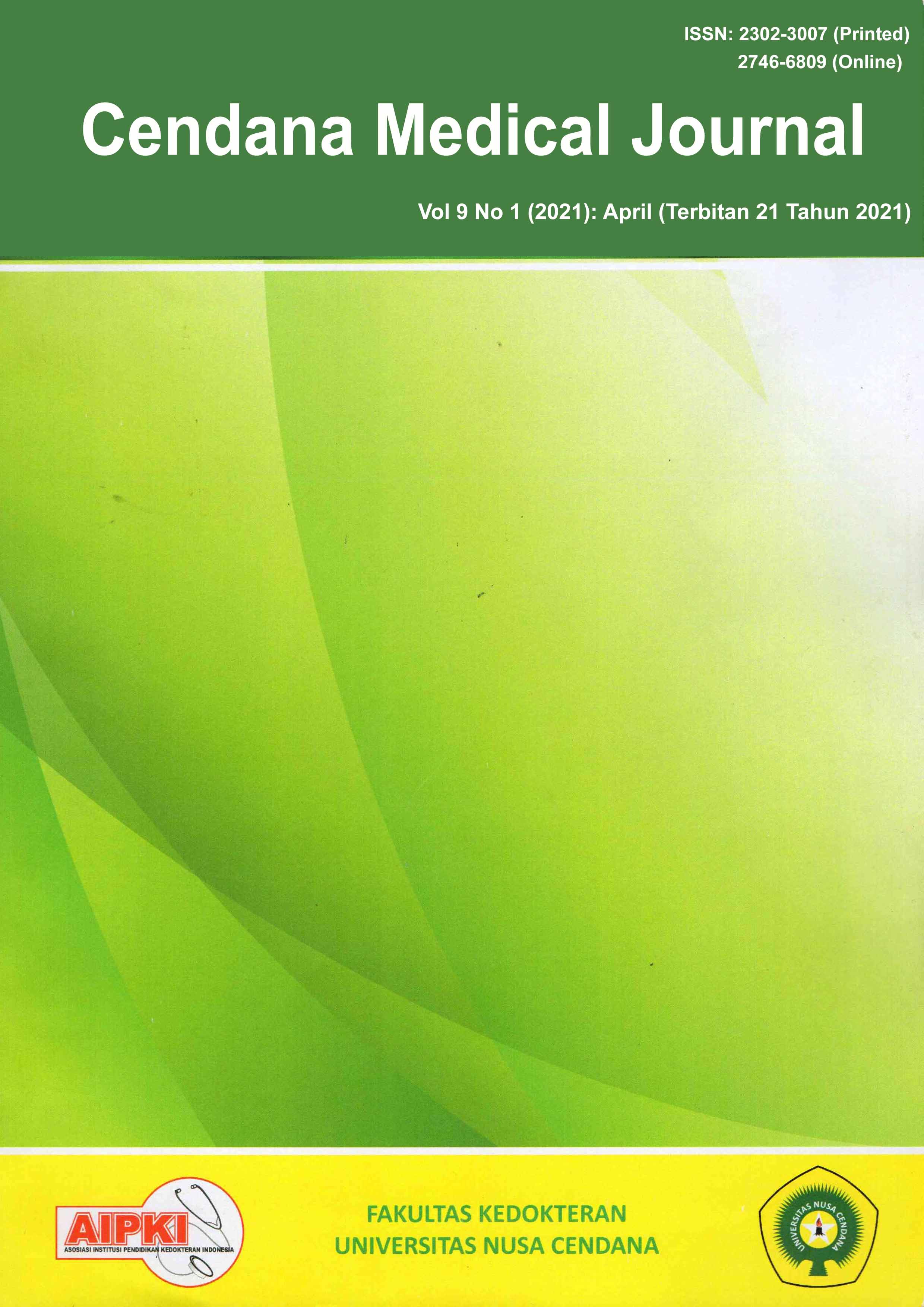HUBUNGAN LETAK LESI STROKE DENGAN KEJADIAN DEPRESI PASCA STROKE PADA PASIEN STROKE DI RSUD PROF DR W Z JOHANNES KUPANG
Abstract
Stroke merupakan penyebab kematian tertinggi kedua dan penyebab disabilitas tertinggi ketiga di dunia. Stroke dapat mempengaruhi kondisi neuropsikiatri pasien, salah satu dampak paling umum ialah depresi pasca stroke yang dapat memperlambat proses pemulihan pasien pasca stroke. Lokasi lesi diduga merupakan salah satu faktor yang berhubungan dengan depresi pasca stroke, namun hal ini masih menjadi kontroversi. Tujuan penelitin ini untuk mengetahui hubungan letak lesi stroke dengan kejadian depresi pasca stroke pada pasien stroke di RSUD Prof. Dr. W. Z. Johannes Kupang. Metode penelitian ini bersifat analitik observasional dengan rancangan cross sectional. Sampel penelitian ini berjumlah 68 orang dan pengambilan sampel menggunakan teknik purposive sampling. Data primer didapat melalui wawancara dengan pasien menggunakan kuesioner Hamilton Depression Rating Scale (HDRS), sedangkan data sekunder didapatkan melalui rekam medik. Hasil dari 68 responden, didapati 31 responden (45,6%) dengan lesi hemisfer kiri dan 37 responden (54,4%) dengan lesi hemisfer kanan. Sebanyak 29 responden (42,6%) mengalami depresi pasca stroke. Terdapat 45,2% responden dengan lesi hemisfer kiri mengalami depresi, sedangkan responden dengan lesi hemisfer kanan yang mengalami depresi sebesar 40,5%. Analisis data dilakukan dengan uji chi square dan didapatkan nilai signifikansi p=0,701 (p>0,05). Kesimpulan penelitian ini tidak terdapat hubungan yang signifikan antara letak lesi stroke dengan kejadian depresi pasca stroke pada pasien stroke di RSUD Prof. Dr. W. Z. Johannes Kupang.
Downloads
References
2. Kanyal N. The Science of Ischemic Stroke : Pathophysiology & Pharmacological Treatment. Int J Pharma Res Rev. 2015;4(10):65–84.
3. Johnson W, Onuma O, Owolabi M, Sachdev S. Stroke: a global response is needed. Bull World Health Organ. 2016;94(9):634-634A.
4. Venketasubramanian N, Yoon BW, Pandian J, Navarro JC. Stroke Epidemiology in South, East, and South-East Asia: A Review. J Stroke. 2017;19(3):286–94.
5. Riskesdas. Riset Kesehatan Dasar Kementerian RI. Proceedings, Annu Meet - Air Pollut Control Assoc [Internet]. 2013;6. Available from: http://www.depkes.go.id/resources/download/general/Hasil Riskesdas 2013.pdf
6. Rajashekaran P, Pai K, Thunga R, Unnikrishnan B. Post ‑ stroke depression cross ‑ sectional study and lesion location : A hospital based. Indian J Psychiatry. 2013;55(4):343–8.
7. Towfighi A, Ovbiagele B, Husseini N El, Hackett ML, Jorge RE, Kissela BM, et al. AHA / ASA Scientific Statement: Poststroke Depression A Scientific Statement for Healthcare Professionals From the American Heart Association/American Stroke Association. Stroke. 2017;48:30–43.
8. Zhang Y, Zhao H, Fang Y, Wang S, Zhou H. The association between lesion location , sex and poststroke depression : Meta- analysis. Brain Behav. 2017;1–11.
9. Daroff RB, Fenichel GM, Jankovic J, Mazziotta JC. Bradley’s Neurology in Clinical Practice. 6th ed. Philadelphia: Elsevier Saunders; 2012. 88–89 p.
10. Ayerbe L, Ayis S, Wolfe CDA, Rudd AG. Natural history, predictors and outcomes of depression after stroke: Systematic review and meta-analysis. Br J Psychiatry. 2013;202(1):14–21.
11. Shi Y, Yang D, Zeng Y, Wu W. Risk Factors for Post-stroke Depression : A Meta-analysis. Front Aging Neurosci. 2017;9(218):1–14.
12. Jiang X, Lin Y, Li Y. Correlative study on risk factors of depression among acute stroke patients. Eur Rev Med Pharmacol Sci [Internet]. 2014;18:1315–23. Available from: https://www.europeanreview.org/wp/wp-content/uploads/1315-1323.pdf
13. Wei N, Yong W, Li X, Zhou Y, Deng M, Zhu H, et al. Post-stroke depression and lession location : a systematic review. J Neurol [Internet]. 2015;262(1):81–90. Available from: https://link.springer.com/article/10.1007%2Fs00415-014-7534-1
14. Yu L, Liu C, Chen J, Wang S, Wu Y, Yu S. Relationship Between Post-stroke Depression and Lesion Location: A Meta-analysis. Kaohsiung J Med Sci [Internet]. 2004;20(8):372–80. Available from: http://dx.doi.org/10.1016/S1607-551X(09)70173-1
15. Bhogal SK, Teasell R, Foley N, Speechley M. Lesion Location and Poststroke Depression: Systematic Review of the Methodological Limitations in the Literature. Stroke. 2004;35(3):794–802.
16. Kultlubaev MA, Hackett ML. Part II: Predictors of Depression after Stroke and Impact of Depression on Stroke Outcome: An Updated Systematic Review of Observational Studies. Int J Stroke [Internet]. 2014;9(8):1026–36. Available from: https://journals.sagepub.com/doi/abs/10.1111/ijs.12356?rfr_dat=cr_pub%3Dpubmed&url_ver=Z39.88-2003&rfr_id=ori%3Arid%3Acrossref.org&journalCode=wsoa
17. Carson AJ, Machale S, House A, Sharpe M. Depression after stroke and lesion location: a systematic review. Lancet J [Internet]. 2000;356(9224):122–6. Available from: https://www.thelancet.com/journals/lancet/article/PIIS0140-6736(00)02448-X/fulltext
18. Sofyan AM, Sihombing IY, Hamra Y. Hubungan Umur, Jenis Kelamin, dan Hipertensi dengan Kejadian Stroke. Medula. 2013;1(1):24–30.
19. Khan FY, Ibrahim AS. Gender Differences in Risk Factors , Clinical Presentation , and Outcome of Stroke : A Secondary Analysis of Previous Hospital ‑ based Study in Qatar. Libyan J Med Sci. 2018;2(2):51–5.
20. Lackland DT, Elkind MS V, Agostino RD, Dhamoon MS, Goff DC, Higashida RT, et al. AHA / ASA Scientific Statement Inclusion of Stroke in Cardiovascular Risk Prediction Instruments A Statement for Healthcare Professionals From the American Heart Association / American Stroke Association. Stroke. 2012;43:1998–2027.
21. Pedroso VSP, Souza LC de, Brunoni AR, Teixeira AL. Post stroke depression : clinics , etiopathogenesis and therapeutics. Arch Clin Psychiatry. 2015;42(1):18–24.
22. Ahn D, Lee Y, Jeong J, Kim Y, Park J. The Effect of Post-Stroke Depression on Rehabilitation Outcome and the Impact of Caregiver Type as a Factor of Post-Stroke Depression. 2015;39(1):74–80.
23. Dong J, Zhang Y, Tong J, Qin L. Depression and Risk of Stroke : A Meta-Analysis of Prospective Studies. Stroke. 2012;43:32–7.
24. Barlinn K, Kepplinger J, Puetz V, Illigens BM, Bodechtel U, Siepmann T. Exploring the risk-factor association between depression and incident stroke : a systematic review and meta-analysis. Neuropsychiatr Dis Treat. 2015;11:1–14.
25. Hedna VS, Bodhit AN, Ansari S, Falchook AD, Stead L, Heilman KM, et al. Hemispheric Differences in Ischemic Stroke : Is Left-Hemisphere Stroke More Common? J Clin Neurol. 2013;9:97–102.
26. Foerch C, Misselwitz B, Sitzer M, Berger K, Steinmetz H, Neumann-haefelin T. Difference in recognition of right and left hemispheric stroke. Lancet. 2005;366:392–3.
27. Portegies MLP, Selwaness M, Hofman A, Koudstaal PJ, Vernooij MW, Ikram MA. Left-Sided Strokes Are More Often Recognized Than Right-Sided Strokes: The Rotterdam Study. Stroke. 2015;46:252–4.
28. Zhang W, Pan Y, Wang X, Zhao Y. A Prospective Study of the Incidence and Correlated Factors of Post-Stroke Depression in China. 2013;8(11):1–5.
29. Snaphaan L, Werf S van der, Kanselaar K, Leeuw F-E de. Post-Stroke Depressive Symptoms Are Associated with Post-Stroke Characteristics. Cerebrovasc Dis. 2009;28:551–7.
30. Robinson RG, Jorge RE. Post-stroke depression: A review. Am J Psychiatry. 2016;173(3):221–31.
Copyright (c) 2020 Cendana Medical Journal (CMJ)

This work is licensed under a Creative Commons Attribution-NonCommercial-NoDerivatives 4.0 International License.
Copyright Notice

This work is licensed under a Creative Commons Attribution 4.0 International License.

 Jeanette Maureen Pongsilurang(1)
Jeanette Maureen Pongsilurang(1)












